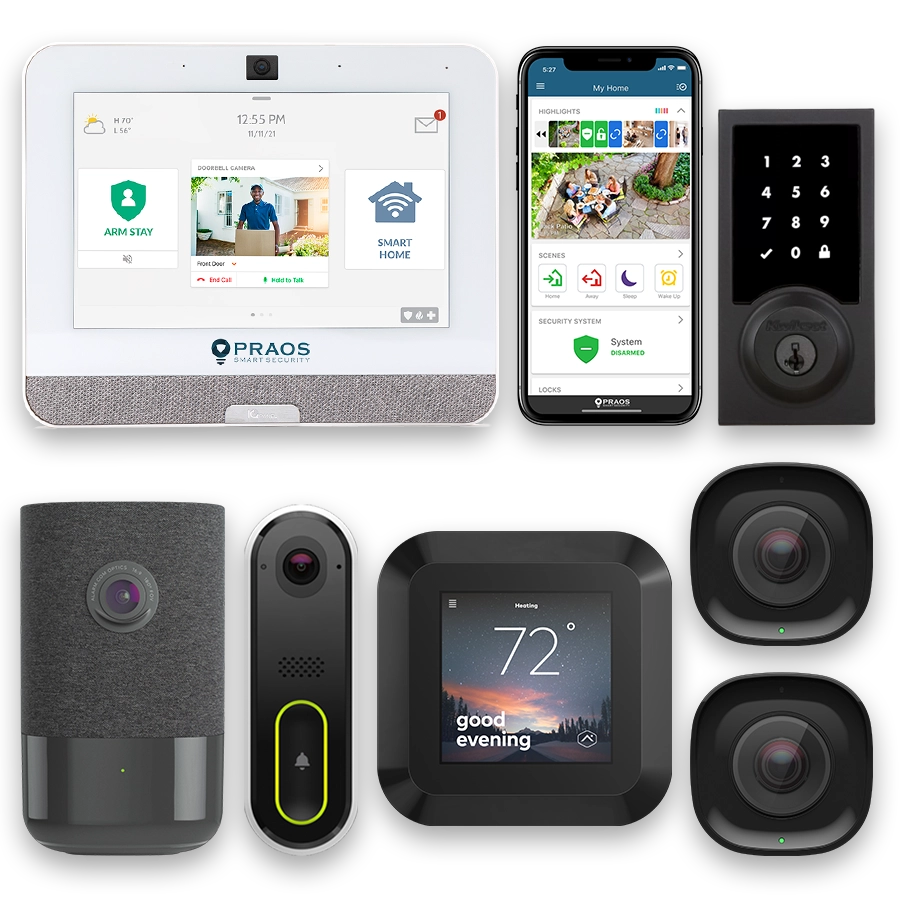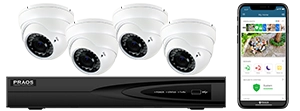Introduction to Home Security Systems
Home security systems have evolved significantly over the years, incorporating advanced technologies and features that cater to various security needs. These systems are designed to provide homeowners with peace of mind, protecting their properties and loved ones from potential threats. Understanding the essential elements of home security systems can help you make an informed decision when choosing the right system for your home.
The primary goal of a home security system is to deter and detect unauthorized entry, ensuring the safety and security of your home. Modern systems achieve this through a combination of surveillance technologies, automated controls, and alert mechanisms. In addition to external threats, these systems can also monitor for internal hazards such as fire and carbon monoxide, further enhancing home safety.
Another crucial aspect of home security systems is their ability to integrate with smart home devices. This integration allows for seamless control and automation of various functions within your home, such as lighting, thermostats, and door locks, all from a single interface. The advancements in wireless technology have made it easier than ever to install and manage these systems without the need for extensive wiring or complex setups.
It is also essential to consider the user interface and ease of monitoring when selecting a home security system. A user-friendly app or control panel can make a significant difference in how efficiently you can manage your security settings and respond to alerts. Many modern systems offer mobile applications that provide real-time updates and allow for remote control, ensuring you stay connected to your home no matter where you are.
Furthermore, reliable alarm and notification systems are vital components of any effective home security setup. These features ensure that you, your family, and emergency services are promptly notified in case of a breach or hazard. Advanced systems offer a range of notification options, including phone calls, text messages, and push notifications, ensuring you are always informed of any potential security issues.
Lastly, when evaluating home security systems, it is crucial to consider the level of customer support and the range of services offered by the provider. Comprehensive customer support can provide peace of mind, knowing that you have access to technical assistance and emergency response when needed. Many providers offer installation services, maintenance plans, and 24/7 monitoring, ensuring your home remains secure at all times.
By understanding these fundamental aspects of home security systems, you can better navigate the myriad of options available and select a system that best meets your specific needs and preferences.
Advanced Surveillance Technology
When evaluating a home security system, advanced surveillance technology is a critical feature to consider. A robust surveillance system acts as the front line of defense in identifying and deterring potential security threats. Here are several components and considerations associated with advanced surveillance technology:
High-Definition Cameras: Modern surveillance systems typically feature high-definition (HD) cameras that provide clear and detailed images. Look for systems that offer at least 1080p resolution to ensure that facial features, license plates, and other important details can be captured with clarity.
Wide-Angle Lenses: Cameras equipped with wide-angle lenses can cover a larger area, reducing the number of cameras needed to monitor a space effectively. This is particularly useful for expansive properties or large interior spaces.
Night Vision Capabilities: Effective surveillance doesn’t stop when the sun goes down. Cameras with night vision capabilities use infrared (IR) technology to capture clear footage in low-light or no-light conditions. This ensures continuous monitoring and security even during nighttime hours.
Motion Detection: Advanced surveillance systems often include motion detectors that trigger recording or alerts when movement is detected. This feature helps conserve storage space and bandwidth while ensuring that only relevant footage is recorded.
Remote Access and Streaming: The ability to access live feeds and recorded footage remotely via a smartphone or computer is an important feature for modern surveillance systems. Remote access allows homeowners to monitor their property in real-time from anywhere in the world, providing peace of mind and prompt response capabilities.
Cloud Storage Options: Cloud storage provides a secure and convenient way to store surveillance footage. It eliminates the risk of losing important video evidence due to hardware malfunction or theft. Many systems offer various cloud storage plans, allowing users to choose the one that best fits their needs and budget.
Integration with Other Security Features: Advanced surveillance systems often integrate seamlessly with other security components, such as door/window sensors, alarms, and smart home devices. This integration allows for a more comprehensive and cohesive security solution.
In summary, advanced surveillance technology is a cornerstone of an effective home security system. By ensuring the presence of high-definition cameras, night vision capabilities, motion detection, remote access, cloud storage, and integration with other security features, homeowners can significantly enhance their security posture and maintain constant vigilance over their property.
Smart Home Integration and Automation
As technology continues to evolve, home security systems are increasingly integrating with smart home devices and automation technologies. This integration not only enhances the functionality of the security system but also adds convenience and efficiency to home management.
Benefits of Smart Home Integration
Smart home integration allows for seamless control and monitoring of various home devices through a single platform. Benefits include:
- Convenience: Control security systems, lighting, thermostats, and other smart devices from a single app or interface.
- Efficiency: Automate daily routines such as turning off lights and adjusting thermostats, leading to energy savings.
- Enhanced Security: Integrate security cameras, smart locks, and motion detectors to create a more comprehensive security network.
Key Features of Automation
When selecting a home security system with smart home integration, look for the following automation features:
- Voice Control: Compatibility with voice assistants like Amazon Alexa, Google Assistant, and Apple Siri for hands-free operation.
- Customizable Routines: The ability to set up routines that automate specific actions based on time, location, or events (e.g., arming security system when you leave home).
- Remote Access: The ability to monitor and control your system remotely via mobile apps.
Compatibility with Smart Home Ecosystems
Ensure the security system is compatible with popular smart home ecosystems such as:
- Amazon Alexa: Many security systems offer skill integrations allowing users to arm, disarm, and check status via Alexa devices.
- Google Home: Google Assistant can be used to control security features and integrated smart devices through voice commands.
- Apple HomeKit: Security systems that work with HomeKit can be controlled through the Apple Home app and Siri.
Smart Home Integration Table
The table below outlines popular home security systems and their compatibility with various smart home ecosystems:
| Security System | Compatible Ecosystems |
|---|---|
| Ring Alarm | Amazon Alexa, Google Home |
| SimpliSafe | Amazon Alexa, Google Home |
| ADT Command | Amazon Alexa, Google Home, Apple HomeKit (limited) |
| Vivint Smart Home | Amazon Alexa, Google Home |
Smart home integration and automation significantly enhance the functionality, convenience, and security of home security systems. By choosing a system that supports various smart home ecosystems and offers robust automation features, homeowners can build a more connected and efficient home environment.
User-Friendly Monitoring and Control Options
Modern home security systems often come equipped with features that allow for easy and efficient monitoring and control. These features ensure that homeowners can manage and respond to incidents quickly and effectively, from virtually anywhere. Below are some key aspects to consider when evaluating the user-friendliness of a home security system’s monitoring and control options.
Mobile App Accessibility
Many of today’s top home security systems provide mobile apps that allow users to monitor their security setup remotely. Through these apps, users can arm or disarm their systems, view live camera feeds, receive notifications, and even control smart home devices. This feature is essential for those who require the flexibility to manage their home security on-the-go.
Customizable Alerts and Notifications
Effective security systems offer customizable alerts, allowing users to set up notifications for specific events such as motion detection, door or window openings, and unusual activity. These alerts can be sent via SMS, email, push notifications, or even automated phone calls, ensuring homeowners are informed immediately of any potential threats.
Intuitive User Interface
For monitoring and control systems to be truly user-friendly, they must have an intuitive and easy-to-navigate interface. This includes clear menus, straightforward instructions, and an overall design that minimizes confusion. An intuitive interface helps ensure that users can operate their security system efficiently, even under stress.
Voice Control Integration
Integration with voice-activated assistants like Amazon Alexa, Google Assistant, or Apple Siri can significantly enhance user convenience. With voice control, users can perform actions such as arming or disarming the security system, checking the status of sensors, and controlling other integrated smart devices without having to use a physical controller or mobile app.
Accessibility Features
It’s important for home security systems to be accessible to all users, including those with disabilities. Features such as screen reader compatibility for visually impaired users, adjustable font sizes, high-contrast modes, and other assistive technologies can make a significant difference in usability for a broader range of individuals.
In conclusion, user-friendly monitoring and control options are crucial for the effectiveness and convenience of a home security system. By ensuring that these features are present, homeowners can maintain better control over their security systems and respond promptly to any threats or incidents.
Robust Alarm and Notification Systems
When it comes to choosing a home security system, a critical feature to consider is the robustness of its alarm and notification systems. The effectiveness of a security system is largely dependent on its capability to detect unauthorized activities and promptly alert the homeowner and possibly emergency response teams. Here are some key aspects to look for:
1. Multiple Alarm Triggers:
A good home security system should support multiple types of alarm triggers. These may include door and window sensors, motion detectors, glass break sensors, and more specialized detectors for smoke, carbon monoxide, and water leaks. The diversity of alarm triggers helps ensure comprehensive protection for different types of threats.
2. Reliable Notification Options:
Timely notifications are crucial for effective response to security breaches. Systems should offer a variety of notification methods, such as:
- Push notifications to mobile devices
- Email alerts
- Text messages (SMS)
- Automated phone calls
Why is this important? Different situations may call for different types of notifications, and having multiple channels ensures the alert reaches you wherever you are.
3. Integration with Emergency Services:
One important feature to seek out is seamless integration with local emergency responders. Some advanced security systems have a direct link to emergency services, allowing for quicker response times. This is particularly useful in situations where immediate intervention is critical, such as fires or break-ins.
4. Redundancy and Backup:
The reliability of the alarm system is enhanced by redundancy features. Look for systems that offer battery backup in case of power outages and those that use multiple communication channels (e.g., both cellular and Wi-Fi) to ensure that alerts can still be sent even if one channel fails.
The following table summarizes the various alarm and notification features you might encounter:
| Feature | Importance |
|---|---|
| Multiple Alarm Triggers | Ensures detection of various threats |
| Reliable Notification Options | Ensures timely alerts through multiple channels |
| Integration with Emergency Services | Facilitates quick response by authorities |
| Redundancy and Backup | Maintains function and reliability during outages |
By prioritizing these attributes, homeowners can ensure their security system effectively guards against a range of potential hazards while providing reliable and timely alerts.
Comprehensive Customer Support and Services
Comprehensive customer support and services are essential components of a home security system. High-quality support mechanisms ensure that users can efficiently resolve any issues that arise, increasing the overall reliability and user experience of the system.
One key aspect of customer support is 24/7 availability. Leading home security providers offer round-the-clock support to address emergencies or technical problems at any time. This ensures that any concerns or challenges can be promptly handled, minimizing downtime and ensuring peace of mind for homeowners.
Another important feature is multiple support channels. To cater to different preferences and situations, providers typically offer various ways to access support, such as:
- Phone support
- Email support
- Live chat
- Online help centers or knowledge bases
These diverse channels ensure that users can find solutions in ways that are most convenient for them.
Effective customer support also involves professional installation services. While some users may prefer to install systems themselves, professional installation ensures that all equipment is correctly set up, reducing the risk of user error and maximizing the system’s effectiveness. Many providers offer both options to meet varying customer needs.
Additionally, ongoing maintenance and updates play a crucial role in the longevity and efficiency of a home security system. Providers that offer routine maintenance services and software updates help ensure that the system remains up-to-date with the latest technology and functions optimally over time.
Lastly, a critical aspect of customer support is the availability of education and training resources. Providers often supply guides, tutorials, and training sessions to help users understand how to operate their systems effectively. These resources empower users to take full advantage of all the features and benefits of their home security setup.
In conclusion, comprehensive customer support and services are vital to the effectiveness and satisfaction derived from a home security system. From 24/7 availability and multiple support channels to professional installation, maintenance, updates, and user education, ensuring these elements are in place can significantly enhance the overall user experience.





